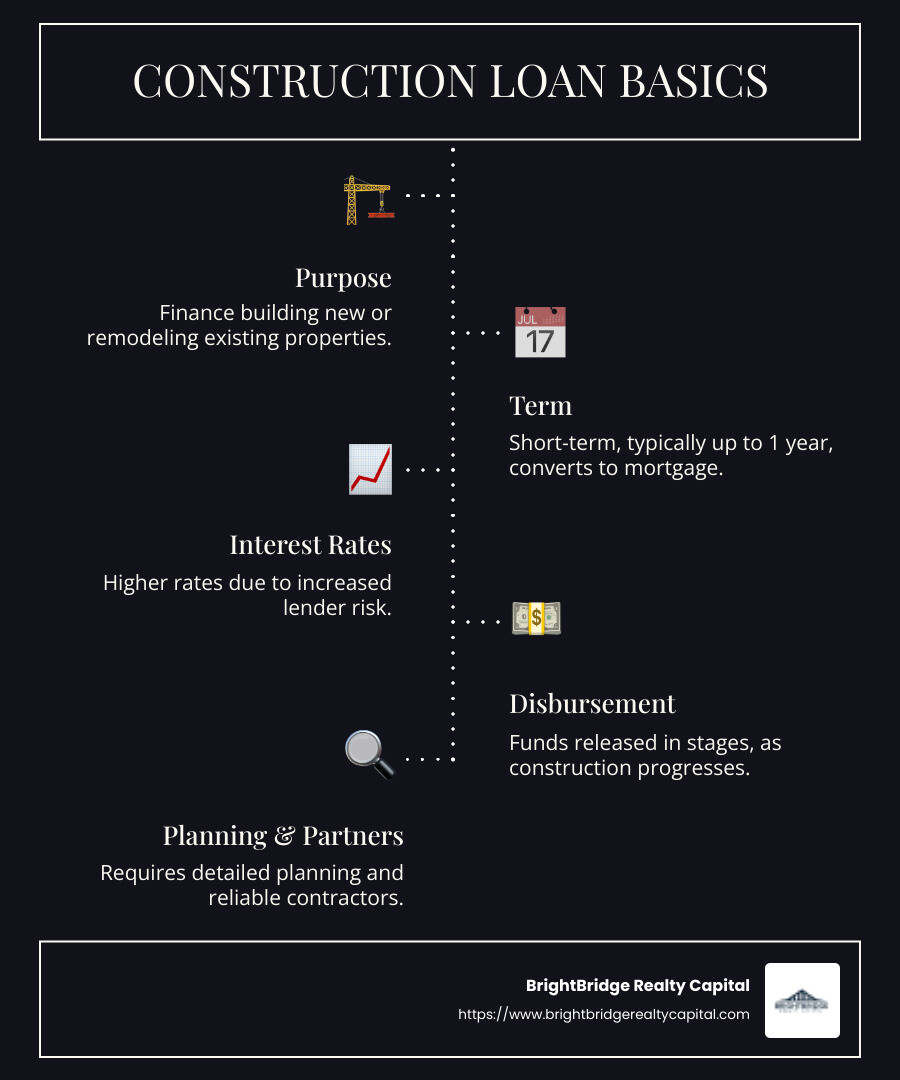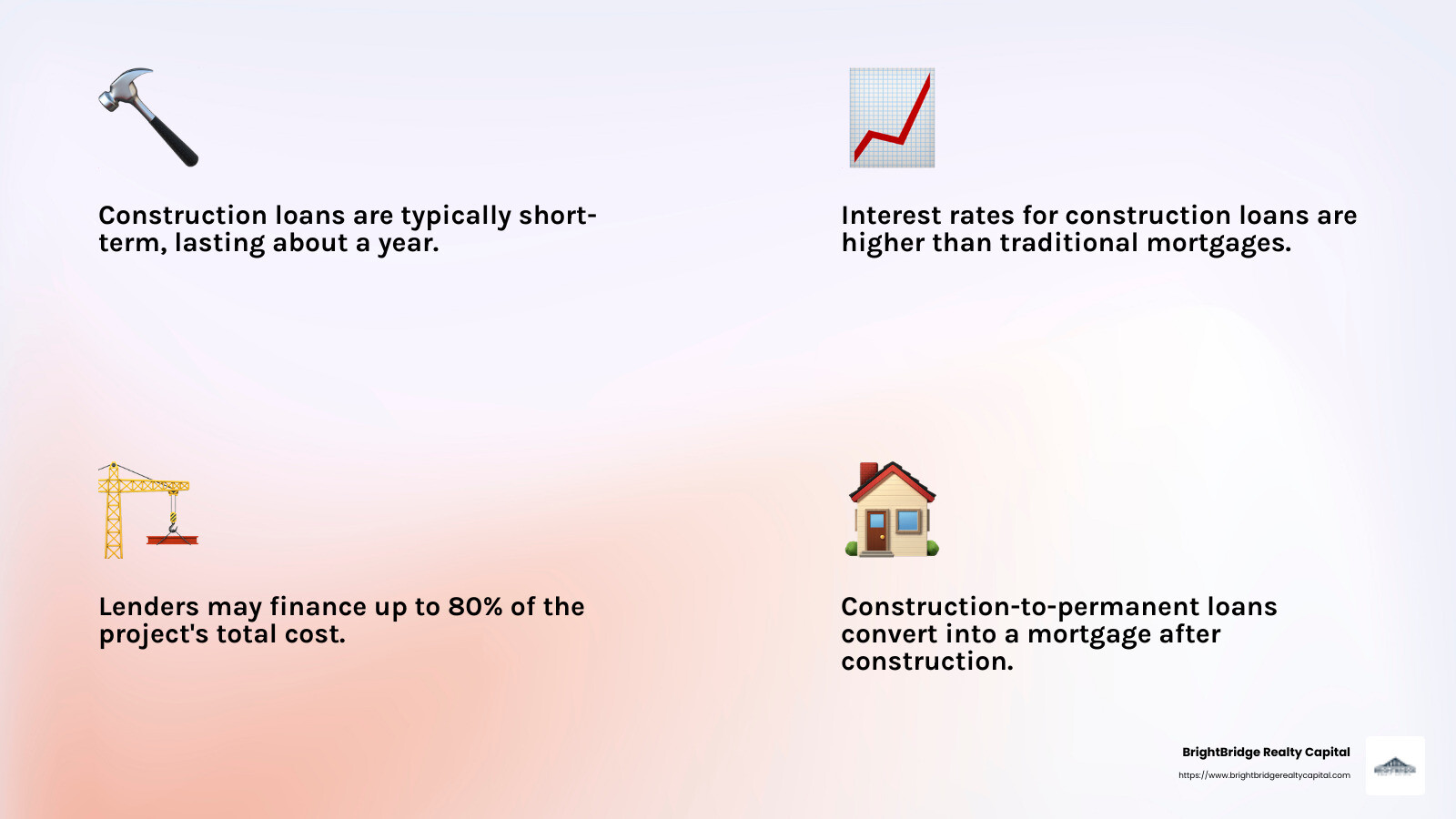From Ground Up: Financing Real Estate Development with Construction Loans

Construction loan real estate development is a dynamic and essential aspect of building and renovating real estate projects.
For investors eager to explore the nuances of construction loans, here is a quick overview:
- Purpose: These loans finance the cost of building new structures or extensively remodeling existing properties.
- Term: Typically short-term, construction loans are usually meant to be paid within a year or converted into a traditional mortgage.
- Interest Rates: Generally higher than traditional mortgages, reflecting the greater risk for lenders.
- Disbursement: Funds are released in stages, aligning with the progress of construction.
Real estate development thrives on the backbone of smart financing, and construction loans stand as a powerful option for those aiming to transform visions into tangible structures. Given their higher risk, these loans are often paired with comprehensive planning and trustworthy contractors. For ambitious property developers, understanding these financial tools is crucial to successful project execution.
"The U.S. remains in a perpetual state of unmet housing demand that continues to drive the delivery of new residential units in a supply-constrained market," notes Alex Ovalle, emphasizing the ongoing opportunities and challenges in the sector.
In an industry where time is money, incorporating the right financing can make all the difference. By leveraging construction loans, investors can efficiently meet market demands and fuel substantial growth in their portfolios.

Understanding Construction Loans
Construction loans are essential tools for anyone looking to build or renovate real estate. They provide the necessary funds to turn blueprints into reality. Let's explore the different types of construction loans and what makes them unique.
Types of Construction Loans
Short-Term Loans
Construction loans are typically short-term, usually lasting about a year. This period is designed to cover the construction phase. Once the project is complete, the loan often transitions into a permanent mortgage or is paid off with a new loan.
Interest Rates
Interest rates for construction loans are generally higher than those for traditional mortgages. This is due to the increased risk lenders face when financing projects that are not yet completed. The rates can vary, and it's crucial for borrowers to shop around for the best terms.
Loan-to-Cost Ratio
The loan-to-cost (LTC) ratio is a critical factor in construction loans. It compares the amount of the loan to the total cost of the project. Lenders typically finance up to 80% of the project's cost. A higher LTC ratio indicates more risk for the lender.
Construction-to-Permanent Loans
These loans start as short-term construction loans and automatically convert into a permanent mortgage once the construction is complete. This option simplifies the process, as borrowers only need to secure financing once. It also provides stability, as the terms of the permanent loan are usually set from the beginning.
Stand-Alone Construction Loans
Stand-alone construction loans are separate from the final mortgage. Borrowers first secure a short-term loan to cover construction costs. Once the project is finished, they obtain a traditional mortgage to pay off the construction loan. This option can be beneficial if the borrower expects to have more favorable mortgage terms in the future.
Renovation Loans
Renovation loans are custom for remodeling existing properties. They cover costs such as contractor labor, materials, and permits. Unlike construction loans for new buildings, renovation loans might consider the property's current equity in the approval process.
By understanding these types of construction loans, borrowers can choose the right option for their needs. Whether building from the ground up or renovating, these financial tools enable real estate development and offer flexibility to meet diverse project requirements.

Next, we'll explore the benefits of construction loans, including their flexibility and potential for interest-only payments.
Construction Loan Real Estate Development
Benefits of Construction Loans
Eligibility Requirements
To qualify for a construction loan real estate development, borrowers need to meet specific eligibility criteria. Lenders often require a solid credit score, usually at least 680. A strong credit history, with no late payments or derogatory marks, boosts approval chances. Additionally, a low debt-to-income ratio (DTI) is crucial, indicating that the borrower can manage the new debt.
Creditworthiness and Down Payment
Lenders assess creditworthiness to mitigate risks. A good credit score assures them of timely repayments. Borrowers generally need a down payment, typically around 20%. This upfront payment demonstrates commitment and reduces the lender's risk. However, owning the land can sometimes offset the down payment requirement, although this approach can be riskier for lenders.
Flexibility
Construction loans offer flexibility that traditional mortgages do not. Borrowers can finance various aspects of the project, from land acquisition to building materials and labor. They also allow for customization, supporting unique construction needs or renovation projects. This adaptability makes them ideal for diverse real estate developments.
Interest-Only Payments
During the construction phase, borrowers usually make interest-only payments. This means they only pay interest on the funds disbursed, not the entire loan amount. This approach eases cash flow during construction, allowing borrowers to focus on project completion without hefty monthly payments.
Future Value Appraisal
One of the standout benefits is the focus on future value appraisal. Lenders consider the property's expected value upon completion, not just its current worth. This can lead to more favorable loan terms, as the property's potential value is a crucial factor in the loan approval and amount.
By understanding these benefits, borrowers can leverage construction loans to effectively manage and finance their real estate projects. These loans provide the necessary support and flexibility to turn ambitious construction plans into reality.
Up next, we'll dive into how construction loans work, including the disbursement process and draw schedule.
How Construction Loans Work
Construction Loan Process
Understanding the construction loan real estate development process can help you steer your project with confidence. Let's break down how these loans work, from application to disbursement.
Application Requirements
Applying for a construction loan involves more than just a good credit score. You'll need to provide detailed documentation, including financial statements, tax returns, and proof of income. A crucial part of the application is the construction plan. This must include architectural drawings, project timelines, and a detailed budget. Think of it as a blueprint for both your home and your loan.
Lender Approval
After submitting your application, the lender will review your creditworthiness and the construction plan. They want to ensure that the project is feasible and that you can repay the loan. Approval hinges on meeting these requirements and demonstrating your ability to manage the project financially.
Disbursement Process and Draw Schedule
Once approved, funds aren't released all at once. Instead, the loan is disbursed in phases, known as draws. Each draw corresponds to a completed stage of construction, such as laying the foundation or installing a roof. Lenders often require inspections before releasing the next draw to ensure work is progressing as planned. This step-by-step release helps keep the project on track and ensures funds are used appropriately.
Interest Payments
During construction, borrowers typically make interest-only payments. This means you only pay interest on the money that has been drawn, not the total loan amount. This can ease your financial burden during the building phase, allowing you to focus funds on completing the construction.
Understanding these elements of the construction loan process can help you manage your project more effectively. Next, we'll explore frequently asked questions about construction loans, including when a homebuyer might need one and how they differ from renovation loans.
Frequently Asked Questions about Construction Loans
When Does a Homebuyer Need a Construction Loan?
A homebuyer typically needs a construction loan real estate development for building a custom home. This is especially true when the home is outside a newly constructed subdivision. In subdivisions, developers often handle financing, even if your house is just a plot of land. But for custom-built homes, you'll need a construction loan to cover the costs from the ground up.
What's the Difference Between a Renovation Loan and a Construction Loan?
The scope of your project will determine whether you need a renovation loan or a construction loan. If you're doing extensive renovations that are almost like building a new home, a construction loan might be necessary. However, if you have equity in your home, a home equity line of credit (HELOC) could be a simpler option. HELOCs often come with lower interest rates since your home serves as collateral, making them ideal for less extensive renovations.
Is a Construction Loan Harder to Get Than a Mortgage?
Yes, getting a construction loan can be more challenging than securing a traditional mortgage. Here’s why:
Credit Requirements: Lenders usually require a higher credit score for construction loans. Many banks look for a score of at least 680, which is higher than what's needed for many conventional VA and FHA loans.
Down Payments: Construction loans often require a minimum down payment of 20%. This can be a hurdle if you don't have significant savings upfront.
Documentation: You'll need to provide a detailed construction plan, a qualified contractor, and a realistic budget. Lenders want to ensure the project's success before approving your loan.
Understanding these aspects can help you better prepare for the application process. Next, we’ll explore how BrightBridge Realty Capital can provide customized financing solutions to meet your needs.
Conclusion
At BrightBridge Realty Capital, we understand the complexities of construction loan real estate development and offer customized financing solutions to meet your unique needs. Our approach is designed to help you steer the often daunting landscape of real estate financing with ease and confidence.
Why Choose BrightBridge Realty Capital?
Customized Solutions: We recognize that every investor's strategy is unique. Whether you're building a new property from scratch or enhancing an existing one, our custom solutions ensure you have the right financial tools at your disposal.
Fast Closings: Time is money in real estate. That's why we pride ourselves on our ability to close deals quickly—often within a week. This speed allows you to seize opportunities as they arise without unnecessary delays.
Direct Lending: By cutting out intermediaries, we offer competitive rates and a seamless process. This direct approach not only saves you time but also ensures that you receive the most favorable terms available.
Our nationwide reach means you're never far from expert assistance, no matter where your project is located. Whether you're in New York or elsewhere, our team is ready to guide you through every step of the construction loan process.
For more information on how we can support your real estate development endeavors, visit our BrightBridge Realty Capital service page.
Let us help you turn your real estate vision into reality with our expert guidance and flexible financing options.


